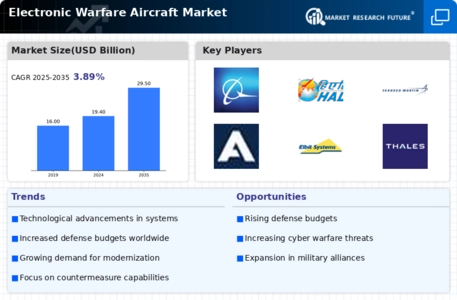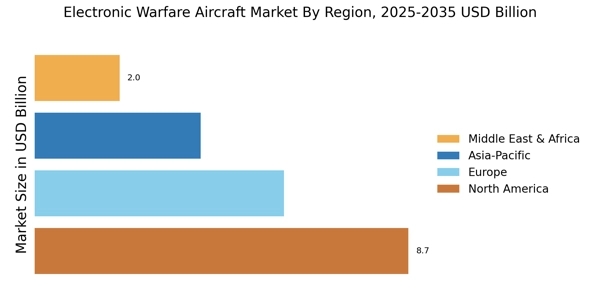Growing Geopolitical Tensions
The Electronic Warfare Aircraft Market is experiencing a surge in demand due to escalating geopolitical tensions among nations. Countries are increasingly investing in advanced military capabilities to counter perceived threats. This trend is reflected in the rising defense budgets, with many nations allocating a significant portion of their expenditures to electronic warfare systems. For instance, the United States has earmarked billions for modernization programs, which include electronic warfare aircraft. This focus on enhancing military readiness suggests a robust growth trajectory for the Electronic Warfare Aircraft Market, as nations seek to bolster their defense mechanisms against adversarial actions.
Increased Focus on Asymmetric Warfare
The Electronic Warfare Aircraft Market is witnessing a shift towards asymmetric warfare strategies, where smaller, technologically advanced forces seek to counter larger adversaries. This paradigm shift necessitates the development and deployment of sophisticated electronic warfare capabilities. Nations are recognizing the importance of electronic warfare in modern combat scenarios, leading to increased investments in specialized aircraft designed for electronic attack and defense. The market is likely to expand as military planners incorporate electronic warfare into their strategic frameworks, emphasizing the need for agile and versatile platforms capable of operating in contested environments.
Advancements in Electronic Warfare Technology
Technological innovation plays a pivotal role in shaping the Electronic Warfare Aircraft Market. Recent advancements in radar jamming, signal intelligence, and cyber warfare capabilities have transformed the operational landscape. The integration of artificial intelligence and machine learning into electronic warfare systems enhances their effectiveness and adaptability. As a result, military forces are increasingly prioritizing the acquisition of advanced electronic warfare aircraft to maintain a competitive edge. The market is projected to grow significantly, with estimates suggesting a compound annual growth rate of over 5% in the coming years, driven by these technological advancements.
Collaborative Defense Initiatives and Partnerships
The Electronic Warfare Aircraft Market is influenced by collaborative defense initiatives and partnerships among nations. Joint development programs and technology sharing agreements are becoming more prevalent as countries seek to enhance their electronic warfare capabilities. These collaborations often lead to the pooling of resources and expertise, resulting in more advanced and cost-effective solutions. As nations work together to address common security challenges, the market is likely to see increased activity, with new platforms and systems emerging from these partnerships, further driving the growth of the Electronic Warfare Aircraft Market.
Rising Demand for Intelligence, Surveillance, and Reconnaissance (ISR)
The demand for enhanced intelligence, surveillance, and reconnaissance capabilities is driving growth in the Electronic Warfare Aircraft Market. Military operations increasingly rely on real-time data and situational awareness, necessitating the integration of electronic warfare systems with ISR platforms. This trend is evident in various defense procurement programs, where electronic warfare aircraft are being equipped with advanced sensors and communication systems. The market is expected to benefit from this convergence, as armed forces seek to leverage electronic warfare capabilities to improve operational effectiveness and decision-making processes in complex environments.


















Leave a Comment